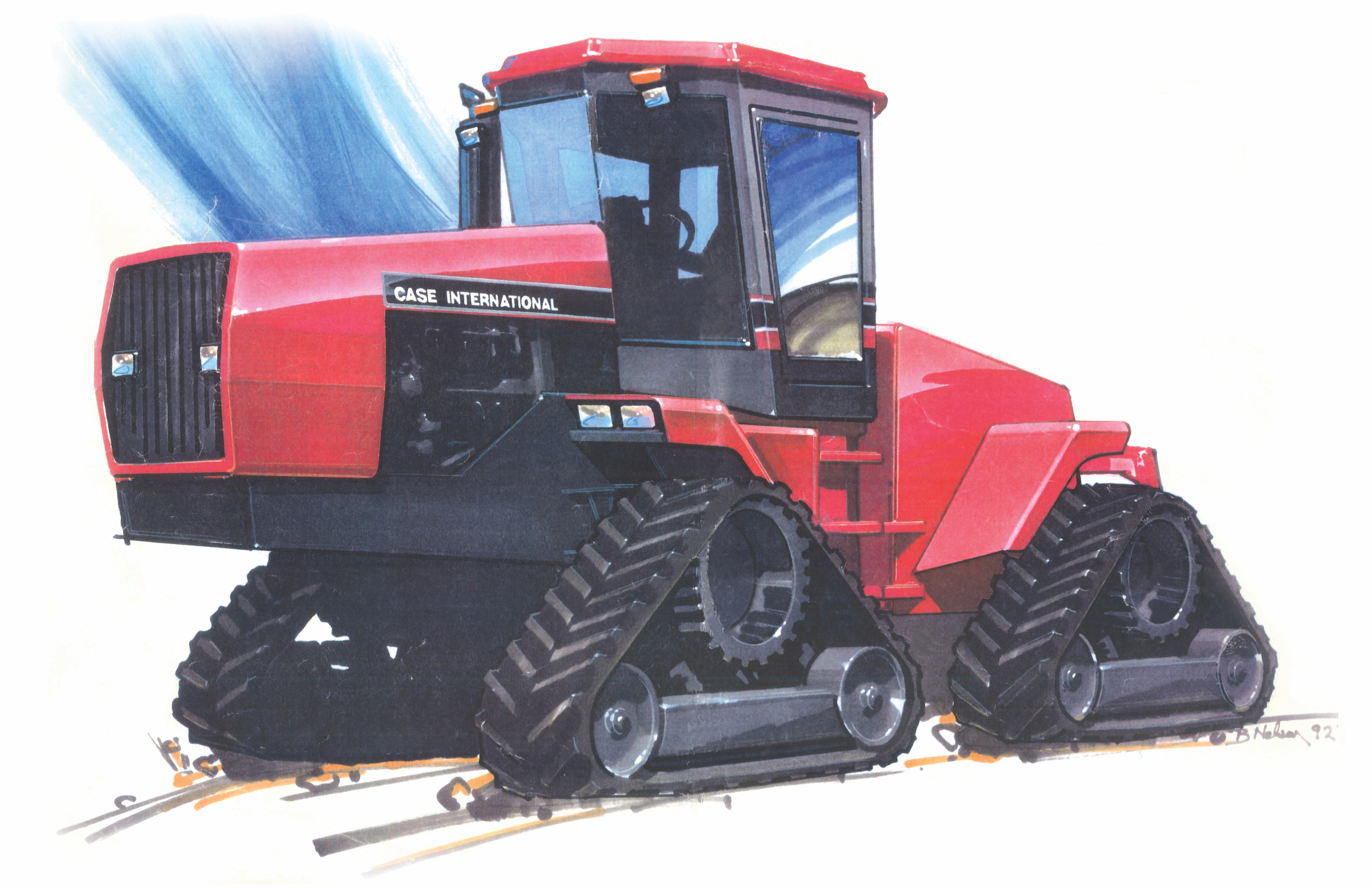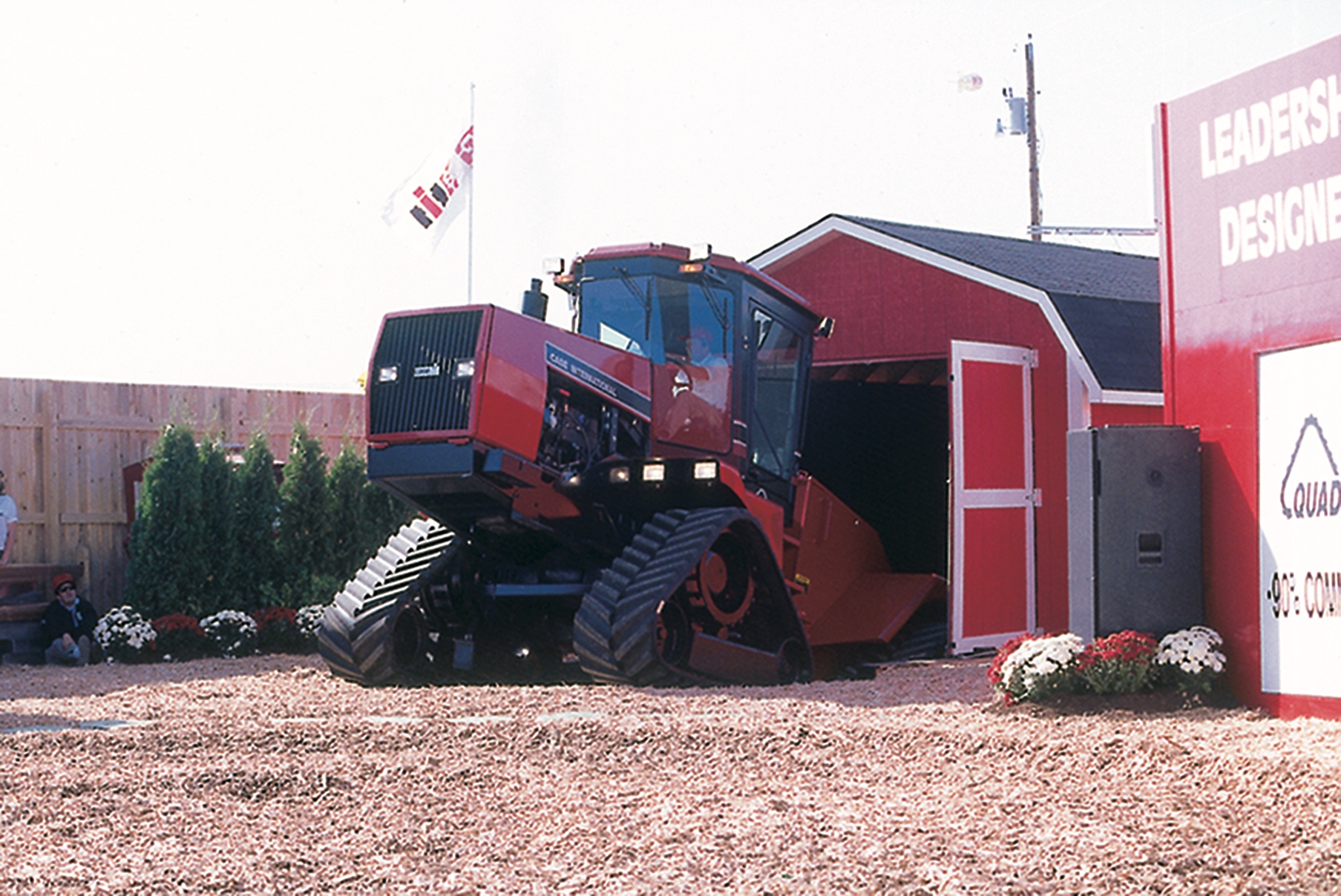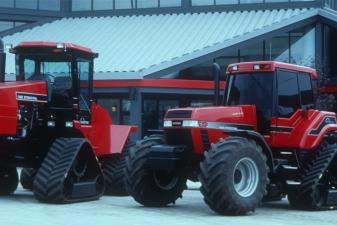Muddy Inspirations: Building Tracked Machines

This article was originally published as a feature in the Ageless Iron section of Successful Farming magazine, where Lee Klancher is a regular contributor.
At about noon on the first day of Farm Progress Days this past August, the darkened skies above Boone, Iowa, delivered on their cloudy promise. The clouds didn’t just deliver, they unleashed a torrent of wind and rain powerful enough to chase attendees off the open grounds and into display tents for shelter.
After about twenty minutes of hard-driving rain, the Farm Progress sound system blared with dire warnings that the show was closing, and everyone must leave the show grounds immediately as much worse weather was on the way.
After the news blared on the PA system that the show was done for the day, the flow of people leaving the grounds turned from a damp trickle to a flood. The parking lot at the show is nothing but a large field, and the rain transformed it into a rutted sea of muck clogged with pickup trucks and unfortunate souls like myself in haplessly spinning two-wheel-drive cars.
Fortunately, the show organizers have an arsenal of weapons to deploy in the case of foul weather. In this case, they were armed with a fleet of four-wheel-drive Gators equipped with large rubber push bumpers used to literally push us out of the lot.
I was able to slither my rental rig out of the lot Tuesday afternoon without a Gator assist but was not so lucky coming back to the show the next morning. My car made it about one hundred yards into the quagmire before spinning itself to a standstill.
One of the Gators headed my way in a few seconds, drove behind my car, and, with a solid bump and a rev of the engine, pushed me about four hundred yards down a row, around a corner, and into a parking spot. The little rig backed away quickly and headed off to rescue the next poor stuck soul.
I guess if you are going to get stuck in the mud or to be precise, to have thousands of cars parked in a mud bog, the place to do that is a farm show, where people with equipment and ingenuity can solve the problem.
Bad weather and axle-deep quagmires are hardly surprising at Farm Progress Days. In 1977, when International Harvester was introducing their new Axial-Flow combine, storms transformed the harvesting fields near the show ground into muddy disasters.
The IH team was able to scrounge a set of rice tires for their brand-new machine and mounted them late the night before the show opened. The next day, while the rest of the combines spun and sunk in the mud, the new red combine’s meaty tires kept it up on plane and happily harvesting. The red team overheard their keenest competitors (hint: green) on the radio, telling their operator to stay away from the “red demon!”
As you might imagine, that story became legend amongst the red ranks.

Early concept drawing of the Quadtrac. Photo courtesy of Case IH
Going further back in time, the swampy soil of the Sacramento-San Joaquin River Delta west of Stockton inspired Benjamin Holt. In the late 1800s, Holt’s father and brothers ran a sawmill and built and sold wood and metal wagon wheels.
In 1890, Holt built an experimental steam traction engine he dubbed, “Old Betsy.” The 48,000-pound beast made 60 horsepower, and was able to efficiently work fields on giant steel wheels.
The wheels were of little use in the muddy soil of the river delta, and Holt began to look for more traction. Tracks were a popular idea at the time. No one had yet built effective tracks, and they were being experimented with most vigorously in England. Holt traveled across the pond to see the new technology firsthand. His experiences watching those experiments fail inspired him to use his family’s skill metalworking to create a system of linked metal drive belts on his machines.
A photographer who saw one of Holt’s early tracked prototypes in motion commented the machine looked like a caterpillar walking. Holt loved the name, and wisely trademarked the name “Caterpillar.”
The Holt tracked machines proved popular, and when Holt merged with Best, they decided to dub their new venture the Caterpillar Tractor Company. This worked out quite nicely for them.
In the late 1970s, Caterpillar would find itself inspired again to produce machines built to thrive in a quagmire. The company sold a good number of smaller crawlers for agricultural use, particularly in California and the Pacific northwest.
The growing number of high-horsepower four-wheel-drive tractors on the market were replacing the Cat farm crawlers. As written by Scott Garvey in the book TRACTOR, Caterpillar decided to look into developing a four-wheel-drive machine of their own.
Engineer Dave Janzen recalls a lunch with three of his colleagues in 1978 in which the group lamented Caterpillar following the crowd to develop a high-horsepower wheeled tractor. The group felt with ample horsepower and speed, a tracked machine could work well for the American farmer.
Janzen and the team shoehorned a Cat 224-horsepower 3306 engine into a D4 chassis. The tracked machine was hitched to a nine-bottom plow and pitted head-to-head against a much larger, 350-horsepower, four-wheel-drive tractor, hitched to a similar nine-bottom plow.
The tracked Cat easily outpulled the larger wheeled tractor. Development of the new Caterpillar agricultural machine began in earnest and required roughly seven years to reach production. The result was the new-for-1986 Caterpillar Challenger 65, a tracked machine that disrupted the market for high-horsepower agricultural tractors.
The Challenger in turn inspired a small group of Case IH engineers to think about how they might apply tracks to their machines. They decided that four tracks would be better than two and were able to convince a track supplier to work with them to retrofit a set of tracks on a 91XX four-wheel-drive tractor.
The four-track prototype was tested in the rich, thick mud of the Red River Valley, specifically in an isolated field hidden in a valley. The people who drove the machine, at times under the cover of darkness, remember to this day the strikingly smooth ride of that rig.
When colorful executive “Tractor” Bob Carlson learned of the machine, he pushed the group to roll it out at Farm Progress Days. In fact, the Quadtrac emerged at the show from a hole in the ground covered with a barn and another evolution of tracked technology surfaced.
The four-tracked machines proved themselves amply capable of navigating ugly conditions, and this mud-inspired innovation is now taking the high-horsepower four-wheel-drive market by storm.

This Quadtrac was a working prototype that was driven at the 1992 and 1993 Farm Progress shows. The undercarriage for this machine was built by Intertractor. Photo courtesy of Case IH
If you would like to read more stories like this one, check out the Related Books linked below.





